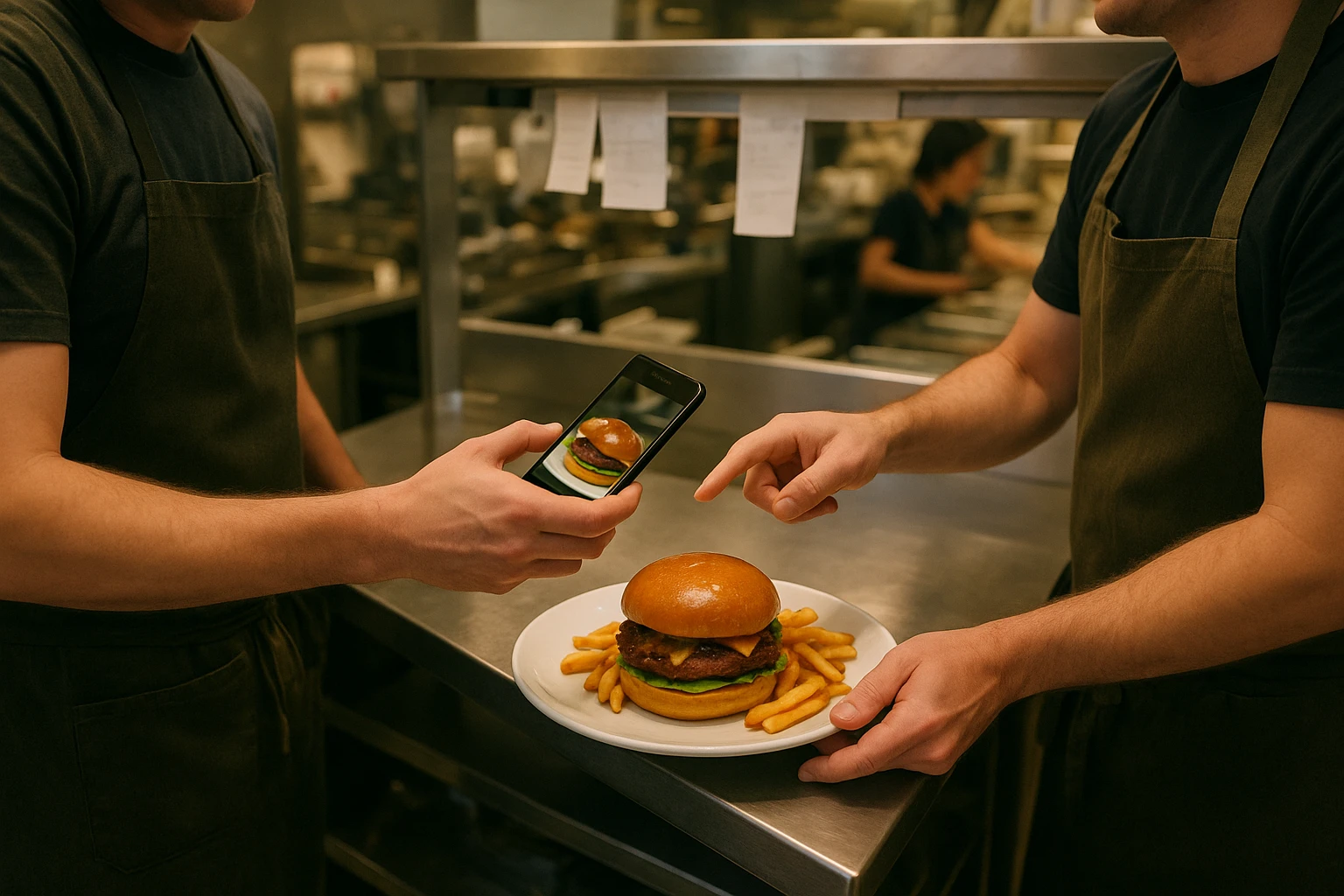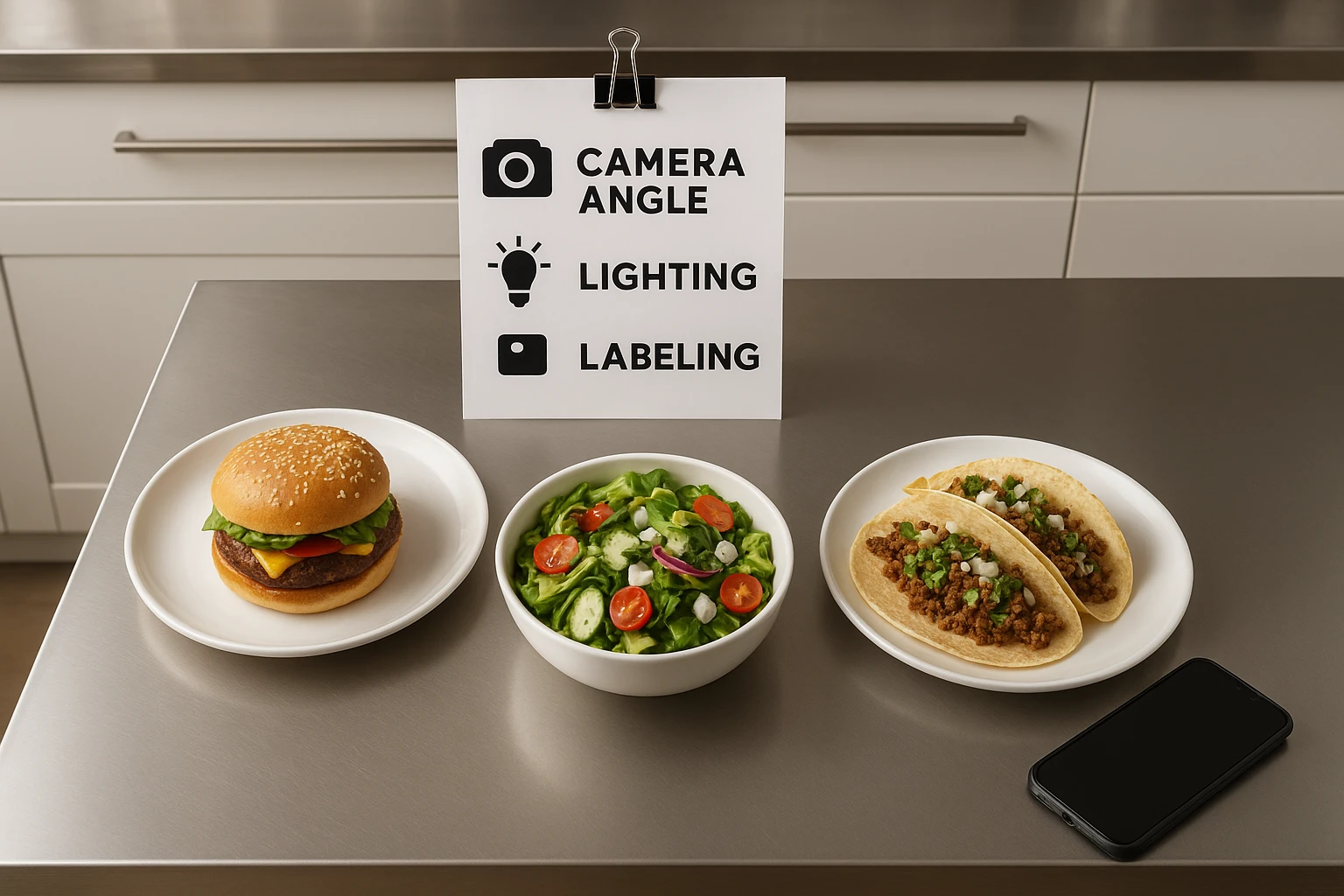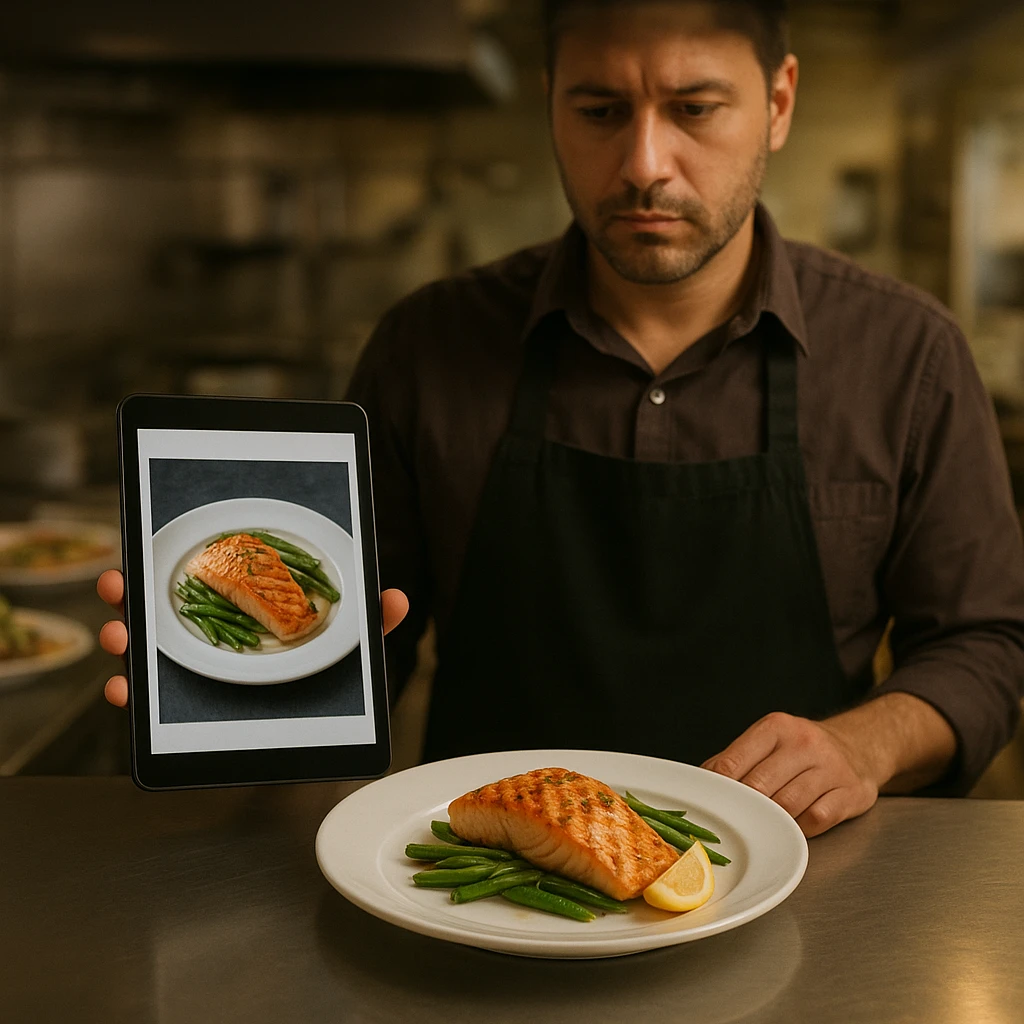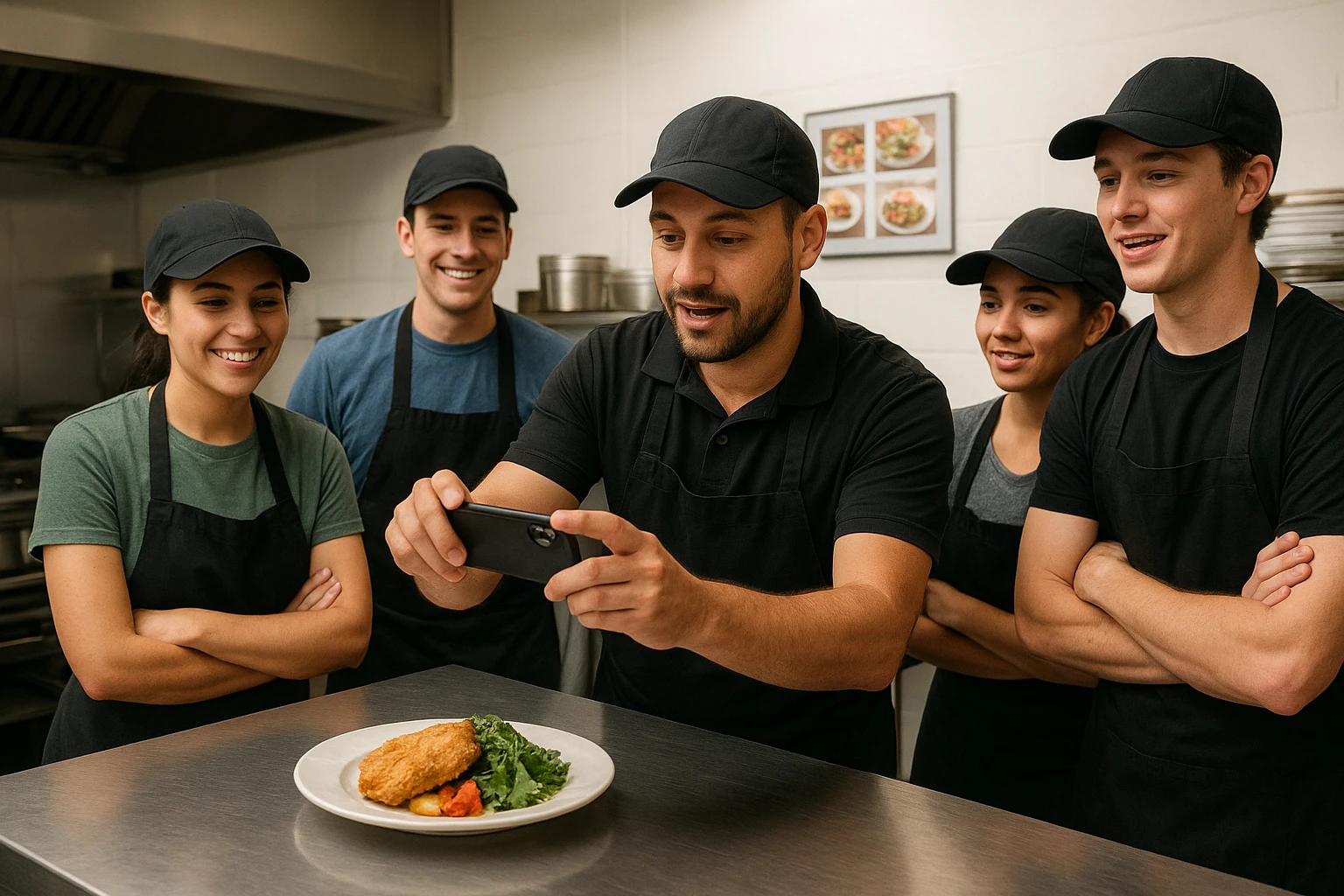Simple Capture Habits For Better AI Food Photos

Quick navigation:
- 1. Why everyday capture habits make or break your AI results
- 2. Design 3-5 simple capture habits any team member can follow
- 3. Make data quality a kitchen discipline, not just an IT idea
- 4. Build capture habits that actually stick in a busy operation
- 5. Plug capture habits into Yummify workflows and measure the wins
1. Why everyday capture habits make or break your AI results
Plan at a Glance: Turn Everyday Photos into AI-Ready Data
| Decision / Metric | What Good Looks Like |
|---|---|
| Primary AI goal | Increase delivery-app click-through on key dishes using better source photos. |
| Who captures images | Any shift lead or trained line cook can capture AI-ready shots in under 60 seconds per dish. |
| Capture frequency | New photo set for each new item, spec change, or plating change; spot refresh every 60-90 days. |
| Data quality bar | Consistent angle, lighting, distance, and clear label (item, variant, date, location). |
| Yummify workflows used | Capture checklist + upload, multi-channel export, analytics loop-back to see what sells. |
It’s 6:45 p.m. on a Friday. Your grill is full, expo is shouting for hands, and a new hire is snapping “photos for Uber Eats” with a greasy phone, harsh overhead glare, and random angles. Those 10 rushed shots are about to do double damage: they become the first impression guests see on delivery apps, and they become the training data your AI tools learn from.
When Yummify turns a reference photo into styled imagery, it’s learning what your dish looks like: color, portion, toppings, overall vibe. If your Buffalo wings photo is dim, cropped, and missing celery, the AI has to guess. According to the People + AI Guidebook, most AI failures come from inconsistent or low-quality input data, not from the model itself. For restaurants, your inputs are everyday phone photos and the labels you attach.
What bad capture habits really cost you
Let’s put it in operator terms:
- A line cook uploads “bowl1-final.jpg” with no label. A week later, marketing uses it for the vegan grain bowl, but the actual plate shows feta and aioli. Now your delivery app shows dairy on a vegan item.
- Two locations plate the same burger differently: one stacks lettuce under the patty, the other piles it on top with extra sauce. Yummify sees both as valid and may generate inconsistent hero shots across your channels.
IBM breaks data quality into accuracy, consistency, completeness, and timeliness. Translate that to your kitchen:
- Accuracy: Does the image match the real plate (ingredients, portion, allergens)?
- Consistency: Does the same item look similar across shots and locations?
- Completeness: Does every photo have a clear label (item, variant, date, location)?
- Timeliness: Does the image match your current spec and price point?
If you’re off on any of these, AI-ready food photos and delivery app menu images will quietly underperform.
Quick reality check: inputs vs outcomes
| If your team’s capture looks like… | Your AI and menu performance will… | Quick fix this week |
|---|---|---|
| Random angles, glare on sauces | Struggle to recognize dishes, produce off-brand variants | Pick one default angle and one lighting rule; post examples by the line. |
| Vague names like “bowl1-final” | Mix up dishes, allergens, and portions | Adopt a 3-part naming rule: Item-Variant-Date. |
| Each store improvises plating | Inconsistent imagery across apps; confused guests | Lock one hero plate per item and photograph that setup only. |
| Photos updated only after complaints | Old prices/portions live for months | Schedule a 15-minute monthly refresh for top 10 sellers. |
Yummify doesn’t magically fix chaotic inputs. What it does is amplify whatever you feed it. Clean, consistent shots in lead to believable, on-brand imagery out, which then flows to your site, your social, and delivery channels without a reshoot.
Ask your managers: if our AI only saw the last 20 photos we took, would we be proud of what it learns?

2. Design 3-5 simple capture habits any team member can follow
You don’t need a 20-page SOP for simple capture habits. You need 3-5 rules that a tired line cook can follow in under 60 seconds.
According to the People + AI Guidebook, small, consistent data-collection routines beat rare “perfect” efforts. In a kitchen, that means building easy, repeatable photo behaviors into the work you already do.
The shift-proof capture habits checklist
Use this as your template; adjust to your menu, then post it where plates are built.
- Pick one angle per category.
- Burgers & sandwiches: 45? angle from the side.
- Bowls & salads: overhead.
- Pizzas & flatbreads: overhead.
- Stand one forearm away. Same distance makes fries, tacos, and wings look like they belong to the same restaurant.
- Use a clean background spot. Choose one pass area or tray liner. No POS screens, tickets, or clutter in frame.
- Kill the harsh flash. Use overhead kitchen lights; if a station is dark, add one clamp light or move 2 steps toward the brightest area.
- Label everything the same way. Use
Item-Variant-Location-Date:SpicyWings-6pc-Downtown-2025-02-01VeggieBurger-NoCheese-Airport-2025-03-15
That naming pattern makes it easier for both humans and Yummify to sort, filter, and avoid mistakes. Guidance from AWS on labeling data recommends consistent, structured labels for more reliable AI performance; you’re doing the same, just with menu items.
Where capture fits into a real shift
Two good slots:
- Pre-shift tastings. When the chef builds the “show plate” to brief staff, the shift lead does a 30-second capture flow.
- Early-service first perfect plate. When the first “10/10” plate hits expo, the photo captain snaps the shot before food leaves the window.
A simple Yummify capture workflow for each plate:
- Snap 2-3 photos following your angle/lighting rules.
- Open Yummify, choose the menu item, and upload the best shot.
- Enter the naming pattern and any allergen or portion notes.
- Save to your branded environment so the AI can generate consistent, styled variants.
To make the habit stick, borrow the “2-minute rule” from behavior science: if a habit takes less than 2 minutes, people actually do it. This short video breaks it down:
Frame capture this way with your team: “One plate, one photo, one upload. Under two minutes.”
Choose three habits from this checklist and test them on one section of your menu this week.

3. Make data quality a kitchen discipline, not just an IT idea
“Data quality” sounds like an IT project, but in your stores it just means: do the photos and labels match reality? Are they current? Can anyone trust them?
According to IBM, high-quality data is accurate, consistent, complete, and timely. Gartner adds that clear ownership and routine checks matter more than fancy tools. Translate that into kitchen moves and you have a simple discipline your managers can run.
Kitchen data quality, decoded
| Data quality dimension | What it means in your kitchen | Simple habit or check |
|---|---|---|
| Accuracy | Photo matches the real plate: ingredients, portion, garnishes, allergens | Once a week, compare a live plate to its Yummify image; recapture if it’s off. |
| Consistency | Same items look similar across locations | Share 1-2 “hero” shots in Yummify and use them as plating standards. |
| Completeness | Each image has item, variant, date, location | Make those four fields required on upload. |
| Timeliness | Images reflect current menu and pricing cues | Set a recurring reminder to review top-seller images monthly. |
| Safety & claims | Images don’t mislead on allergens or diets | Cross-check allergen-sensitive items against your allergen SOP before publishing. |
Two scenarios show why this matters:
- Hypothetical multi-unit issue. One location quietly ups the fry portion to reduce complaints, but your photos still show the old smaller side. Guests at other stores expect the bigger basket they saw online and start leaving “small portion” reviews.
- Real-world allergen risk. A “gluten-friendly” pizza photo clearly shows regular crust. Even if the text is correct, the mismatch can confuse guests and increase your risk of complaints or worse.
Assign ownership and bake checks into existing routines
You don’t need a new role; you need clear owners:
- Store level. The GM owns photo accuracy and timeliness. A designated “photo captain” per shift handles actual capture and upload.
- Central marketing or ops. Own consistency across locations and final approval for branded environments in Yummify.
Add one quick visual check to your weekly manager walk-through:
- Pick 3 best-sellers.
- Open their images in Yummify on a tablet.
- Compare to fresh plates on the line.
- Log any that need a new photo or label tweak.
Add one simple “image and label quality” check to your next weekly manager walk-through.

4. Build capture habits that actually stick in a busy operation
The biggest risk isn’t designing capture habits-it’s watching them disappear after week two.
To make simple capture habits survive Friday nights and staff turnover, you need behavior design, not just memos. Start tiny, attach the habit to routines that already happen, and let peers coach each other.
Attach capture to routines you already run
Good anchors:
- Pre-shift line check. After checking temps and taste, the shift lead picks one hero plate to photograph.
- Manager sign-off on new items. No item goes live on delivery apps until it has a Yummify-ready photo attached.
- Weekly menu talk. Use 5 minutes to review last week’s photos on a TV or tablet, calling out one “great capture” and one “let’s improve this.”
Because these routines already exist, capture feels like an extra 30 seconds, not a new job.
14-day rollout playbook (pilot before you scale)
Use this with one category (say, burgers) in one store:
- Pick your pilot. One store, one category.
- Post visuals at the line. Print 3 hero shots and your 3-5 capture rules; tape them where plates are built.
- Demo in pre-shift for 3 days. Shift lead shows the capture + Yummify upload flow on a live plate.
- Assign a photo captain per shift. That person owns 2-3 captures and same-day uploads; rotate weekly.
- End of week one review. Look at 10 photos together, celebrate wins, and agree on 1-2 tweaks.
- Week two: add one more category. Maybe salads; repeat steps 2-5. Only then push out to other locations.
Hypothetically, this keeps your risk low. If it fails, it fails in one corner of your operation-not across the whole brand.
Schedule a single 10-minute pre-shift this week to pilot the 14-day rollout playbook with one menu category.

5. Plug capture habits into Yummify workflows and measure the wins
Capture habits matter because they plug directly into how you use Yummify and your delivery apps.
When a shift lead uploads a clean, labeled photo into Yummify, it flows through your restaurant AI workflow:
- Upload & label. Assign the photo to a menu item, use your naming pattern, and add notes (e.g., “contains peanuts”).
- Apply a branded environment. Choose your saved style-“Bright Lunch,” “Rustic Cantina”-so AI-generated images match your brand across all dishes.
- Export to channels. Use Yummify exports to update your website gallery, marketing assets, or delivery app imagery.
- Review performance. Over time, combine Yummify stats with delivery app dashboards to see which visuals actually move clicks and orders. For deeper testing, see A/B Testing Food Photos.
Simple metrics: from habit to revenue
Track a short list of metrics monthly:
| Metric | Where to see it | What it tells you | Action trigger |
|---|---|---|---|
| Photo coverage (% of menu with AI-ready photos) | Yummify menu view | How complete your library is | If coverage <80%, schedule a capture block for missing items. |
| Photo freshness (days since last update on top 20 items) | Item details + your own log | Whether images match current plating | If >90 days, refresh those items. |
| Delivery-app click-through on key dishes | Delivery partner dashboards | How compelling your images are to guests | If CTR dips vs last month, capture a new reference photo set. |
| Image-related complaints | Guest feedback, internal logs | Where photos may mislead on portions/allergens | If a dish gets repeated complaints, audit images and recapture. |
You don’t need a PhD in analytics. You just need to know: do we have current photos for our best-sellers, and are they helping or hurting?
Once these metrics are visible, it becomes much easier to justify 15 minutes per month for new captures. It also sets you up to use guides like Pass Every Check: Delivery-App Image Guidelines and AI Workflows and Close the Loop: Tie Food Imagery to Analytics and Sales for more advanced optimization.
Log into Yummify and check photo coverage and freshness for your top 20 sellers, then choose three items to refresh this week.

Next steps
If you only do one thing from this guide, make it this: pick one menu category and one store, define 3-5 capture rules, and run the 14-day pilot. Use Yummify to upload, label, and style those reference photos, then update your delivery app images for just three top sellers. Watch how click-through, reviews, and re-orders respond over the next month. Once you see that better everyday inputs create better AI results, you’ll have the proof you need to scale simple capture habits across your entire operation.
FAQ
How many photos per dish do I really need for good AI results?
You don’t need dozens of shots per item. In most cases, 2-4 well-framed, clearly labeled reference photos per dish are enough for strong AI-ready food photos. Focus on one default angle plus 1-2 backups to cover variations like toppings or sides. The key, as the People + AI Guidebook notes, is consistency in how and when you capture data, not raw volume. More messy photos will not beat a small library of clean, standardized images.
Do I need special cameras or lights, or are team phones enough?
For most operators, modern smartphones plus decent kitchen lighting are enough to start. A simple add-on, like an inexpensive clamp light near your “photo spot,” can dramatically improve clarity without a big investment. Reserve professional photographers for quarterly hero shoots or brand campaigns where you truly need studio-level control. If a location has extremely poor lighting or very old phones, consider designating one mid-range shared device as the capture phone and keeping a portable light at the pass.
How often should I refresh photos for best-sellers versus slower items?
A practical baseline is every 60-90 days for best-sellers and every 90-120 days for slower movers, or any time you change plating, ingredients, or pricing cues. The exact cadence depends on how frequently your menu and specs change. IBM’s guidance on data quality stresses timeliness as a core factor; stale images are a direct parallel in your operation. Use a simple log or Yummify’s item views to track “last updated” so managers can quickly see which dishes are overdue for a refresh.
What’s the safest way to show allergens and dietary options in photos?
The safest approach is to make sure the photo and the text tell the same story and never hide visible allergens. If your “nut-free” pad thai has a peanut-garnished version in some stores, that garnish should never appear in the photo used for allergen-sensitive guests. AWS labeling guidelines emphasize clarity and consistency in labels; apply that idea by clearly tagging allergen-related items in Yummify and your menu system. When in doubt, choose a conservative image that does not overpromise dietary claims and back it up with clear written allergen information.
How do these capture habits actually connect to higher conversion or sales?
Better capture habits improve the accuracy and appeal of the images guests see before they ever taste your food. Clear, consistent photos make dishes easier to understand, reduce unpleasant surprises, and increase the odds that a guest will click and order-especially on delivery apps where images often drive decisions. Gartner notes that higher data quality underpins better business outcomes, and McKinsey highlights frontline behavior change as critical to digital performance. In your case, small behavior changes around photos and labels feed more reliable AI outputs, which support clearer menus, more effective A/B tests, and fewer image-related complaints-each of which can help your top line over time.
What if different locations plate the same item differently and images look inconsistent?
Start by agreeing on one “hero” plate per item, then document it with a clear photo and a short plating note. Share that hero photo in Yummify and in your kitchen playbooks as the single source of truth. When stores deviate, it creates confusion for guests who expect what they saw online and complicates AI training with conflicting visual signals. Use your weekly or monthly reviews to spot-check plates against the hero image, and when a spec genuinely changes, recapture the new hero plate and update it everywhere instead of letting variation creep in.


